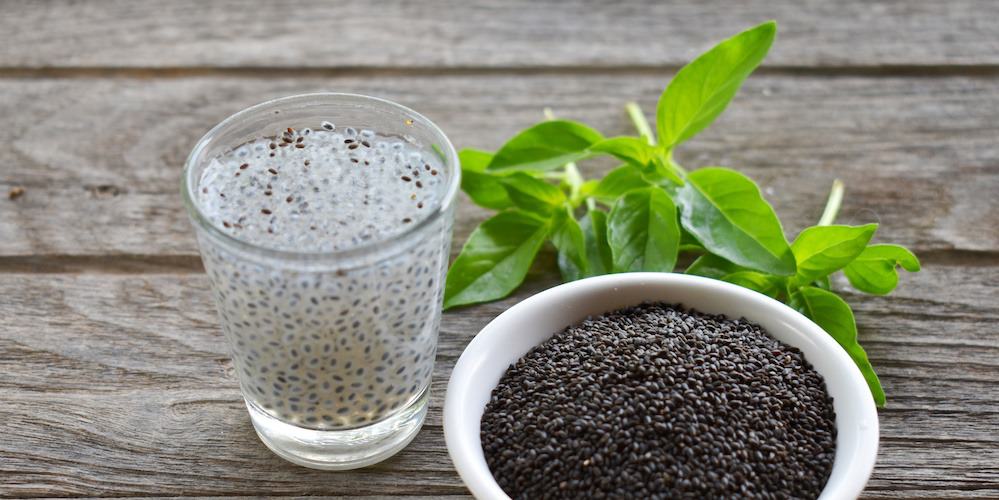BENEFITS OF BASIL SEEDS
✓ Source of fiber
✓ Source of fatty acids
✓ Have an antioxidant effect
✓ Reduce fever
✓ Would alleviate inflammatory bowel diseases
What are basil seeds?
Basil (Ocimum basilicum) is a plant whose fragrant leaves are used in cooking. It belongs to the Lamiaceae family, which includes many other aromatic plants: mint, rosemary, sage, thyme… The Ocimum genus includes different varieties of basil such as common basil, large green basil, or Tulsi or holy basil (Ocimum tenuiflorum).
Also called “royal herb,” basil is native to South Asia. It is a perennial plant that can reach 60 cm in height. It produces many waffled leaves in different shades of green. From June to September, basil offers a lovely bloom of pale pink and purplish flowers. After wilting, it produces seeds to multiply. Basil seeds are fine, black, and elongated.

Gradually, basil cultivation spread throughout Asia and the countries around the Mediterranean. Traces of its use are found during ancient Egypt and Greece, where it was part of traditional pharmacopeia.
According to this review, basil was notably indicated to relieve diarrhea, headaches, digestive disorders, and lung conditions. In these cases, it was the leaves or flowering tops of basil that were used.
But it’s less commonly known that the seeds also contain many benefits.
Basil seeds are an excellent source of fiber, known to improve transit. They are also rich in proteins, minerals, trace elements, fatty acids, and antioxidant actives. This exceptional composition allows them to have beneficial effects on the body. They may help reduce fever and hold promise for alleviating inflammatory bowel diseases.
Still relatively unknown, basil seeds deserve their place among superfoods, alongside chia seeds.
Nutritional Composition
- Vitamins: Vitamin A, beta-carotene, C, K
- Minerals and trace elements: potassium, magnesium, calcium, iron
- Fiber
- Proteins
- Carbohydrates
- Fatty acids: alpha-linolenic acid, linoleic acid
- Essential oils
- Antioxidant actives: polyphenols, polysaccharides, flavonoids
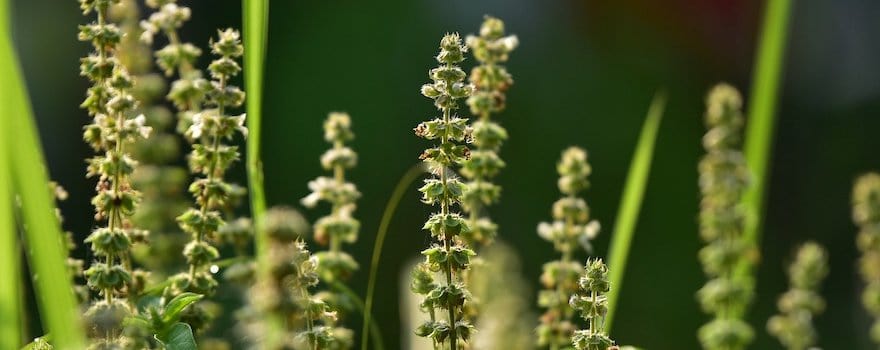
The Benefits of Basil Seeds
♻️ Source of Fiber
Basil seeds contain a significant amount of dietary fibers, particularly soluble fibers. Thus, 1 tablespoon of basil seeds provides 6 g of fiber, helping to partially meet the recommended daily needs (25 to 30 g of fiber per day).
Fibers play an important role in transit and intestinal health. They promote the elimination of toxins, improve digestion, and nourish the microbiota. Fibers also create a feeling of fullness, an interesting action when looking to avoid snacking, stay in shape, or lose weight.
The fibers in basil seeds also have a beneficial effect on blood sugar control in case of type II diabetes. Indeed, by slowing down the absorption of carbohydrates, they regulate blood sugar levels and prevent blood sugar spikes.
Finally, basil seeds help reduce bad cholesterol (or “LDL cholesterol”). Their soluble fibers act like a sponge, absorbing the bad cholesterol transported in the blood and eliminating it.
This study from the University of Sharjah (India), conducted on diabetic rats, shows how the aqueous extract of basil seeds reduced blood glucose levels.
🐟 Source of Fatty Acids
Basil seeds are packed with fatty acids. They mainly contain alpha-linolenic acid (ALA), a polyunsaturated fatty acid from the omega-3 family. Also present in chia seeds, it is a precursor of other omega-3s like eicosapentaenoic acid (EPA) and docosahexaenoic acid (DHA).
Alpha-linolenic acid plays an important role in many physiological functions. It is particularly involved in good cardiovascular health and the functioning of the central nervous system.
Basil seeds also contain linoleic acid, a polyunsaturated fatty acid of the omega-6 type. This acid contributes to the structure of cell membranes, plays a role in the inflammatory response, and the functioning of the immune system.
This study from Azad Islamic University (Iran), conducted on basil seeds, shows the differences in fatty acid composition and quantity according to their geographical origins.
🥝 Exert antioxidant action
Basil seeds contain antioxidant compounds including polyphenols, flavonoids, and polysaccharides. All have a powerful action against free radicals.
By fighting against free radicals and their formation, basil seeds prevent numerous damages to the body. They limit cellular aging and reduce the risk of cardiovascular diseases.
During this study by the University of Nizwa (Oman), conducted directly in the laboratory, researchers showed that basil seeds contain a large amount of antioxidant phenols (785.76 mg/100 g).
🌡 Reduce fever
Basil seeds have an antipyretic effect, meaning they combat feverish states. They act on the febrile response and the abnormal increase in body temperature.
Like aspirin, basil seeds inhibit the formation of prostaglandins, molecules that uphold fever. They are effective in cases of feverish states linked to an infection, inflammation, or following the intake of certain medications.
This study from Sultan Qaboos University (Oman), conducted on rats, demonstrates how basil oil extracted from seeds significantly reduced the febrile response.
🌵 May relieve inflammatory bowel diseases
Some researchers have focused on the action of basil seeds to relieve inflammatory bowel diseases (IBD): Crohn’s disease, ulcerative colitis…
This review from the Tehran University of Medical Sciences (Iran) suggests they could be effective in combination with other plants like black nightshade, blond psyllium or boswellia, a powerful anti-inflammatory.
However, further studies are still needed to confirm the beneficial effects of basil seeds on inflammatory bowel diseases.
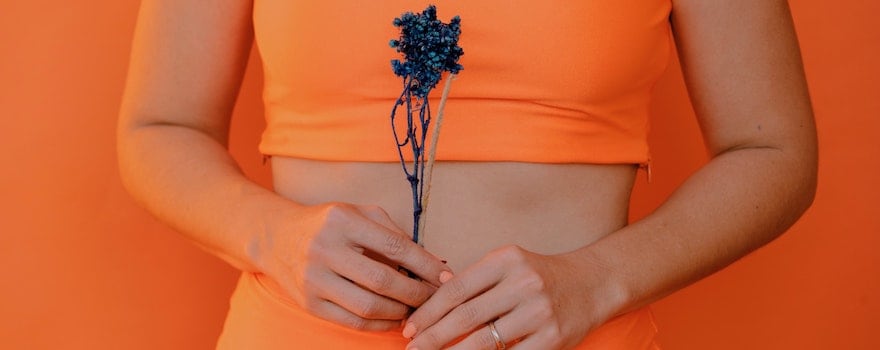
How to consume basil seeds?
Dried basil seeds
Basil seeds are most often offered in sachets. They are first harvested, then dried and packaged. It is the simplest form and the easiest to find in stores, in specialized shops, or online.
Before consuming them, it is essential to soak them in water for about 15 minutes. Use 13 g of seeds for 240 ml of water. This allows them to swell, take on a gelatinous texture, and release nutrients beneficial to the intestine.
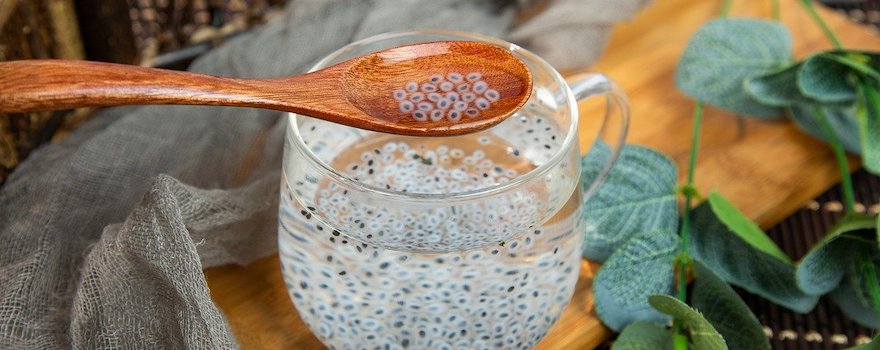
Dried basil seeds can be simply consumed with water or added to fruit juices, smoothies, yogurts, ice creams… They are also used in the preparation of many traditional drinks like Falooda, an Indian milk drink that combines basil seeds with tapioca pearls from cassava. You can even reinvent the famous chia pudding by replacing chia seeds with basil seeds!
Basil seeds for sprouting
It is also possible to find basil seeds for sprouting, which are interesting for their nutritional qualities. Indeed, it is during full germination that basil seeds contain the maximum nutrients.
This technique is performed in a germination cup and can take up to 20 days. Once the sprouts reach about 3 cm, they are consumed raw, as an herb, in salads, in vinaigrettes… Their taste is reminiscent of pesto.
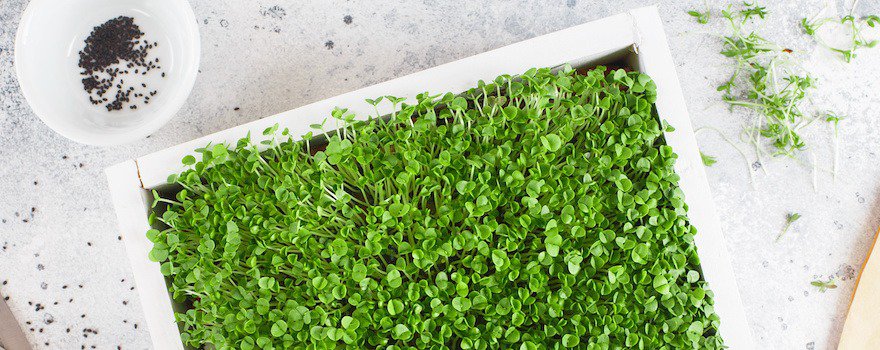
Basil seeds and superfoods
To improve digestion, basil seeds pair well with other fiber-rich superfoods like chia seeds, carob seeds, and hemp or psyllium.
To lose weight, basil seeds can be consumed in a drink or infusion with matcha tea or yerba mate.
Consume sustainably: prioritize organic, local, and fair-trade basil seeds
✓ Unfortunately, aromatic plants are also subject to chemical treatments: pesticides, insecticides, fungicides… It is not uncommon for basil to be among the plants regularly monitored for illegal substances or those present above the regulatory threshold. Sometimes, residues of pyriproxyfen or mercaptodimethur, powerful chemical agents, are found. This is why it’s better to choose basil seeds grown organically, without chemical pesticides or insecticides.
✓ Basil thrives in our regions. Many French producers grow and offer fresh basil. However, few cultivate it for its seeds. The choice of dried basil seeds is still limited, and they most often come from India or Egypt. In this case, prioritize fair-trade sectors that ensure fair income for small producers and contribute to local projects.
Dosage
There is no specific recommended dosage for consuming basil seeds. Just make sure not to overdo it.
Dried basil seeds: up to 20g per day
Contraindications and side effects
The consumption of basil seeds has certain contraindications:
- As a precaution, the consumption of basil seeds is not recommended for young children;
- Due to their effect on estrogen levels, pregnant or breastfeeding women should avoid taking basil seeds;
- People suffering from blood clotting disorders should also avoid consuming them;
- Basil seeds can interact with certain blood coagulation medications.
Excessive consumption of basil seeds can lead to the following side effects:
- Difficult digestion
- Bloating
If you experience side effects, stop consumption and consult a doctor.
History, culture, and market of basil seeds
Basil seeds are of interest to many sectors today. In the food industry, they are used as a texturizing agent due to their gelling and thickening action. Some brands also offer detox or appetite-suppressant drinks with basil seeds.
The gelatinous mucilage surrounding basil seeds also has utility. Due to its water retention capacity, it is used in the manufacture of hydrogel dressings.
As for the basil seed gum derived from the mucilage, it is used as an emulsifying, foaming, thickening, gelling, binding, and stabilizing agent in the food and pharmaceutical industries.
File produced by Julia Perez and Charlotte Jean
Sources and scientific studies
Shadi Sarahroodi, Somayyeh Esmaeili, Peyman Mikaili, Zahra Hemmati, and Yousof Saberi, 2012. The effects of green Ocimum basilicum hydroalcoholic extract on retention and retrieval of memory in mice.
Sachin Chaudhary, Amit Semwal, Hitesh Kumar, Harish Chandra Verma, Amit Kumar, 2016. In-vivo Study for Anti-Hyperglycemic Potential of Aqueous Extract of Basil Seeds (Ocimum Basilicum Linn) and Its Influence on Biochemical Parameters, Serum Electrolytes and Hematological Indices.
Sahar Mostafavi, Hossein Ali Asadi-Gharneh, Mohammad Miransari, 2019. The Phytochemical Variability of Fatty Acids in Basil Seeds (Ocimum Basilicum L.) Affected by Genotype and Geographical Differences.
Fazal Mabood, Syed Abdullah Gilani, Javid Hussain, Sulaiman Alshidani, Said Alghawi, Mohammed Albroumi, Saif Alameri, Farah Jabeen, Zahid Hussain, Ahmed Al-Harrasi, Zahra K M Al Abri, Saima Farooq, Zakira Naureen, Ahmad Hamaed, M Rasul Jan, Jasmin Shah, 2017. New Design of Experiment Combined With UV-Vis Spectroscopy for Extraction and Estimation of Polyphenols From Basil Seeds, Red Seeds, Sesame Seeds and Ajwan Seeds.
M.Y. Al-Maskari, Muhammad Asif Hanif, A.Y. Al-Maskri, Samir AlAdawi, 2012. Basil: A natural source of antioxidants and nutraceuticals.
Roja Rahimi, Mohammad Reza Shams-Ardekani, and Mohammad Abdollahi, 2010. A review of the efficacy of traditional Iranian medicine for inflammatory bowel disease.
Siriporn Tantiwatcharothai, Jutarat Prachayawarakorn, 2019. Property Improvement of Antibacterial Wound Dressing From Basil Seed (O. Basilicum L.) Mucilage- ZnO Nanocomposite by Borax Crosslinking.
Sara Naji-Tabasia, Seyed Mohammad Ali Razavib, 2017. Functional properties and applications of basil seed gum: An overview.


